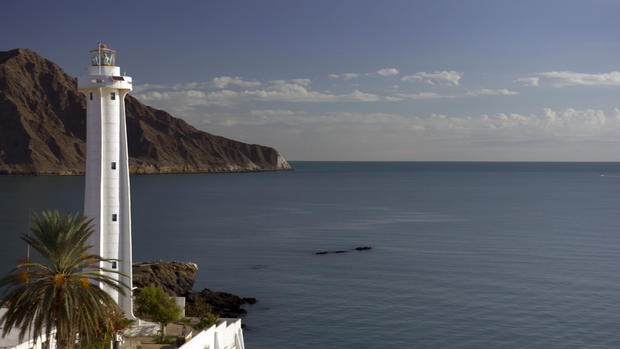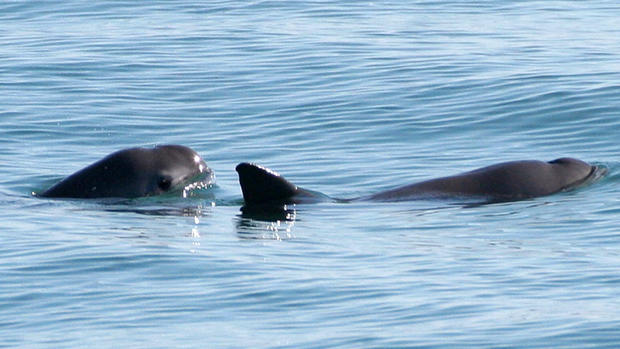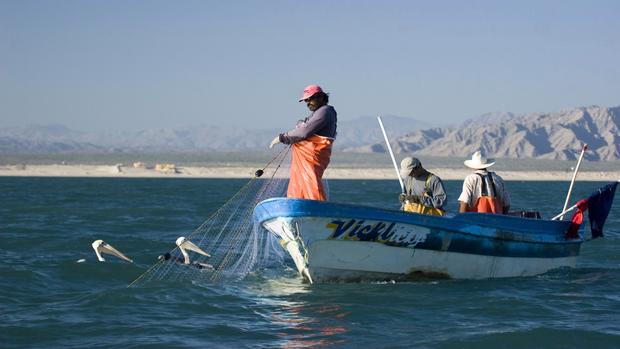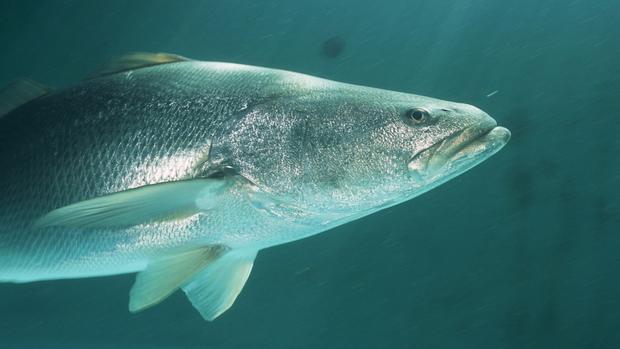The Last Vaquitas
The following script is from "The Last Vaquitas" which aired on May 22, 2016. Sharyn Alfonsi is the correspondent. David Schneider and Joyce Gesundheit, producer.
You would think the most endangered sea mammal in the world would be a cause célèbre -- complete with a star-studded, high profile campaign to save it. But that's not the case with the vaquita, a small porpoise with a distinctive face that's on the verge of extinction.
It lives in waters off Baja California where the Mexican government is trying to save the vaquita by paying fishermen not to fish. Scientists from the U.S. and Mexico set sail recently to count the last vaquitas still in existence. It's not easy because their numbers are dwindling and the animals are notoriously elusive. That's one reason why most people have never heard of vaquitas and fewer have seen one. We didn't expect to see any either.
To have any chance of seeing a vaquita, we had to travel to the only home they have on the planet: the northern end of the Gulf of California. It's a stunning landscape of desert, sea and sky that's home to nearly a third of all marine mammal species in the world. On the map, these waters look like a slender finger separating Baja California from the rest of Mexico. But out on the open sea it seems vast and empty. Last fall, a joint Mexican-U.S. scientific survey crossed these waters to count the last vaquitas still alive.
Man on Microphone: Station calling Ocean Starr.
The morning we sailed out to meet the Ocean Starr, the expedition's research vessel, we were expecting to only see scientists.
"It's been impossible to sell the vaquita to nature shows because they want underwater, full frame videos of vaquita and they live in muddy waters."
A vaquita sighting is barely more than a glimpse of a dorsal fin and an arched back. They usually travel alone or in pairs, like a mother and her calf. What you don't see is that they're tiny -- the smallest porpoise in the world, about five feet long and a hundred pounds. Locally, it's known as the "vaquita marina," which in Spanish means "little sea cow." It's unique black eye rings and lips lead some to call it the panda of the sea, but it has a PR problem.
Barb Taylor: It's been impossible to sell the vaquita to nature shows because they want underwater, full frame videos of vaquita and they live in muddy waters.
Barb Taylor works at NOAA -- the National Oceanic and Atmospheric Administration -- and is co-chief scientist on the survey expedition.
Barb Taylor: If you look out there now it's a sea of triangles. And what we're looking for is a little triangle.
The spotters spend much of their time looking through the Big Eyes -- 25 power binoculars which can spot a vaquita up to two miles away. This is the third expedition to count vaquitas since 1997. The population then was estimated at 567. A decade later, the number had dropped to 245 -- less than half.
Sharyn Alfonsi: What's your best guess? How many vaquita are left?
Barb Taylor: I think there's certainly fewer than 100.
Sharyn Alfonsi: Fewer than 100?
Barb Taylor: Fewer than 100 individuals left, which is, as I say, very critically endangered. And it may be fewer. I mean that's why we're out here.
Lorenzo Rojas-Bracho: We cannot lose it. I mean, we-- this is our species, our marine mammal species.
Lorenzo Rojas-Bracho is with Mexico's National Institute of Ecology and is the expedition's other chief scientist. He's been studying the vaquita for nearly 20 years. None are in captivity and he says our knowledge of the animal is limited.
Lorenzo Rojas-Bracho: We know they breed every other year. They're slow breeders. So--
Sharyn Alfonsi: They breed every other year?
Lorenzo Rojas-Bracho: Every other year. So that the impact of that is that the cov-- recovery will not be very fast, of course. We know very little from their behavior. We know they are very shy animals.
Sharyn Alfonsi: What do you mean shy?
Lorenzo Rojas-Bracho: They don't like boats or noise. So if you approach them, they will tend to go away.
In recent years, many of the sightings have been of dead vaquitas. The small one in this photo is a calf. A healthy vaquita can live for 20 years...but most don't. They're dying at the hands of their only known predator: fishermen and their gillnets. Hundreds of miles of gillnets are lowered from fishing boats to drift with the tide and catch fish and shrimp. There's no money to be made from catching vaquita -- they're just collateral damage.
Sharyn Alfonsi: What's the problem with gillnets?
Barb Taylor: They're basically an invisible net in the water. The fishermen put out the net. They sit and let the net soak, so there's no motors going. And the animals just get tangled in them and drown.
Last April, Mexican President Enrique Pena Nieto announced a ban on the use of gillnets for at least two years. It was an extraordinary, last ditch effort to save the vaquita.
Sharyn Alfonsi: You've lived here your whole life. Have you ever seen a vaquita?
Sunshine Rodriguez: Never.
Sharyn Alfonsi: Never?
Sunshine Rodriguez: I cannot say I have.
Sunshine Rodriguez is the president of the Federation of Coastal Fishermen which represents more than 600 from the town of San Felipe... including those who work on his six boats.
Sunshine Rodriguez: I'm not gonna lie, I'm not gonna say they don't exist. But out of 20 fishermen that I have, one has seen a vaquita.
Sharyn Alfonsi: What does that tell you?
Sunshine Rodriguez: It's gonna be very hard for them to save 'em. I believe that the government came in too late for them, unfortunately. For us, we're in our best interest to save it. But if not, we want our ocean back. We want our old habits of fishing with what we had.
Barb Taylor: A lot of fishermen say, absolutely truthfully, that they have never caught a vaquita in their net. The reason for that is that their grandparents caught a lot of vaquita in their net. Their parents caught some vaquita in the net. And now that we're down to less than 100 individuals it's an extremely rare event.
For generations, the fishermen of San Felipe have depended on gillnets to pull in their catch of shrimp and fish, like croaker and shark.
Sunshine Rodriguez: Everybody in our federation has stopped their boats. We don't go out there. But these people are gonna get tired.
Sharyn Alfonsi: Of sitting here and--not fishing.
Sunshine Rodriguez: Of sitting-- not doing anything.
Faced with a ban, they're trying to figure out another way to fish with new nets that won't kill vaquita. So far, results have been mixed. The test run with this prototype was disappointing - just five fish were caught.
Sharyn Alfonsi: This is it?
Fisherman: Uh-huh (affirm).
Sharyn Alfonsi: For the day, this is all you got?
Fisherman: Ay.
Sunshine Rodriguez: If you're gonna tell me that I'm gonna go out there and work 12 hours a day instead of making $30 a day, I'm gonna be making $5 a day, it's not gonna work. We're not gonna--
Sharyn Alfonsi: But--
Sunshine Rodriguez: --respect it.
Sharyn Alfonsi: --but what if you're gonna make a little bit less, and then you might also save the vaquita?
Sunshine Rodriguez: If it's a little bit less, we're willing to sacrifice it. But what's a little bit less for you? What's a little bit less for them?
For two years, fishermen are being compensated for their lost catch -- the Mexican government is paying them $60 million not to fish. If you drive around San Felipe today, there are more boats on land than at sea with fishermen tending to their pets, not their nets. They know they risk losing the fishing industry permanently in San Felipe if they can't certify their new methods are vaquita-friendly. U.S. seafood buyers and restaurants are considering boycotts if gillnets go back in use.
Rafael Pacchiano: It would be very bad, especially for the Upper Gulf. Because 100 percent of the products that they fish, they export it to the U.S.
Rafael Pacchiano is Mexico's Secretary of Environment and Natural Resources and the point man on saving the vaquita.
Sharyn Alfonsi: How difficult is it to get people to care about an animal that they never see?
Rafael Pacchiano: That's one of the main challenges for taking care of natural resources. First of all, you have to let people know that they exist. Because no one takes care of what they don't know
But the threat to vaquita from commercial fishing is now being overtaken by the threat coming from criminal enterprise. In February, environmental activists from Sea Shepherd pulled this net and its catch from the water. It's the work of poachers going after what may be the most valuable fish in the sea. Meet the totoaba, a fish that, like the vaquita, can only be found in the Gulf of California. It, too, is endangered. But unlike the vaquita, there's money to be made in poaching totoaba -- from this: it's a swim bladder, an organ which helps the fish maintain buoyancy.
Lorenzo Rojas-Bracho: They open the totoaba, and they throw away the meat and they just throw it to rot in the beach.
Sharyn Alfonsi: So they just want the bladder?
Lorenzo Rojas-Bracho: They just want the bladder.
Eventually, the bladders end up in Hong Kong and China where they are believed to possess medicinal value which gives them monetary value. The environmental group Greenpeace used hidden cameras to capture Hong Kong merchants trying to sell totoaba swim bladders. The prices went up to $40,000.
Lorenzo Rojas-Bracho: This hunger for endangered species is killing vaquitas here. Because the mesh size of the gillnets for totoaba is about the size of a head of a vaquita. So they get easily entangled.
Scientists say the big money from China for poached totoaba is now the single biggest factor driving the vaquita to extinction.
Lorenzo Rojas-Bracho: And they were paying at some point $8,500 U.S. for a kilo of the swim bladder.
Sharyn Alfonsi: $8,500 for a kilo?
Lorenzo Rojas-Bracho: 8,500 for a kilo--
Sharyn Alfonsi: That's-- that's drug money.
Lorenzo Rojas-Bracho: That's drug money. So a friend says cocaine of the sea. And I was saying it's like if--
Sharyn Alfonsi: Cocaine of the sea?
Lorenzo Rojas-Bracho: Yeah.
Over the past year, the Mexican Navy has confiscated hundreds of gillnets and fishing boats. It may have dented the poaching, but hasn't stopped it. This spring, a Sea Shepherd drone discovered poachers operating at night. After being spotted, they cut their gill net loose and fled. Sea Shepherd has found numerous nets with totoaba along with three dead vaquita. In recent years, poachers have smuggled millions of dollars of totoaba swim bladders out of Mexico. Sunshine Rodriguez admits the big money is tempting to everyone.
Sunshine Rodriguez: Totoaba is a gold rush of the year 2015 in San Felipe, you know? Anybody that has a boat that says, "Well, if I catch three, four or 20 of those, I make $20,000, $30,000, $50,000. I'm gonna go ahead and-- and risk it."
Sharyn Alfonsi: Do you think they can stop the poachers?
Sunshine Rodriguez: It's a big ocean.
All of this has nothing to do and yet everything to do with the vaquita -- which no one is trying to kill or capture. Seeing vaquitas in the wild is exciting, but the drama mostly comes from knowing the animal is rarely seen and soon may never be seen again.
A week ago, Barb Taylor and Lorenzo Rojas-Bracho announced the results of the survey they led in the Gulf of California. They now estimate there are only about 60 vaquita left in existence.




